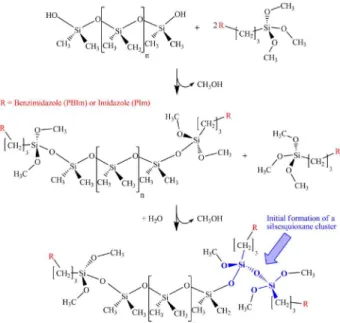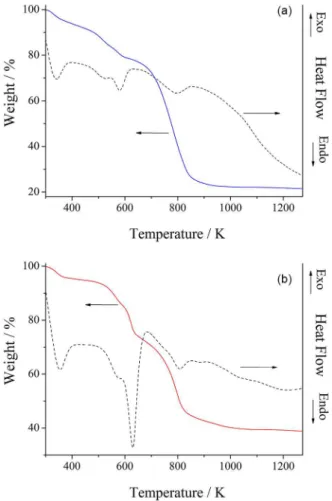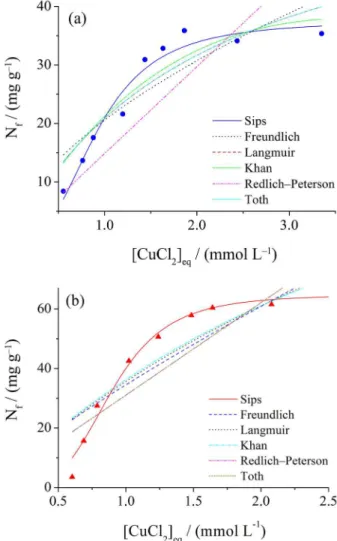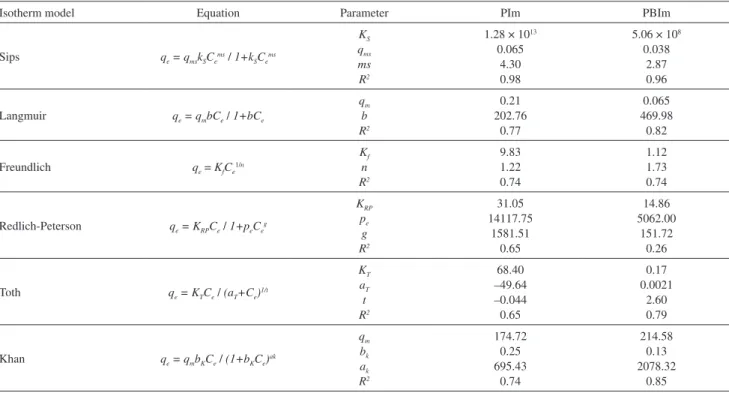Article
Printed in Brazil - ©2015 Sociedade Brasileira de Química0103 - 5053 $6.00+0.00
A
*e-mail: fabio.pissetti@unifal-mg.edu.br, flpissetti@gmail.com
Synthesis of Poly(Dimethylsiloxane) Networks Functionalized with Imidazole or
Benzimidazole for Copper(II) Removal from Water
Fábio L. Pissetti,*,a Pedro L. de Araújo,a Fábio A. B. Silvaa and Gaël Y. Poirierb
aInstituto de Química, Universidade Federal de Alfenas, 37130-000 Alfenas-MG, Brazil
bInstituto de Ciência e Tecnologia, Universidade Federal de Alfenas,
37715-400 Poços de Caldas-MG, Brazil
Functionalized elastomeric networks were obtained via a polycondensation reaction between poly(dimethylsiloxane) (PDMS) containing Si(CH3)2OH as end groups and an imidazole- or benzimidazole-modified alkoxysilane. Thestructure of the polymeric materials was characterized via attenuated total reflectance Fourier transform infrared spectroscopy (ATR-FTIR) and solid-state 13C and 29Si NMR spectroscopy, which indicated the presence of silsesquioxane units that acted as nodes on the PDMS chains and linked the functional groups. Thermogravimetric analysis (TGA) of the product indicated high thermal stability with an initial weight-loss temperature around 450 K. The capacity for the removal of copper(II) from aqueous solution was estimated from adsorption isotherms, yielding values of 35.74 and 66.09 mg g−1, respectively, for benzimidazole- and imidazole-functionalized materials. The major adsorption models were evaluated to fit the removal data of copper(II) and the model elaborated by Sips was determined to provide the best fit for both prepared materials.
Keywords: poly(dimethylsiloxane), imidazole, benzimidazole, elastomeric network,
copper(II), adsorption
Introduction
Toxic metal ions released into environmental water are a concern because they can be absorbed by plants and animals, thereby becoming concentrated in living
organisms and altering the ecosystem.1 The treatment of
effluents that contain low concentrations (ppm) of heavy metals is important for promoting water reuse. Various methods, including chemical precipitation, ion exchange, adsorption, membrane filtration, and electrochemical treatment technologies, are currently used to treat such
waste prior to discharge.2,3
As described in several studies, adsorption is recognized as an effective and economic method of heavy-metal removal that offers flexible operation and has the potential to achieve a high-purity effluent. In addition, some adsorbent materials can be regenerated via desorption processes, thereby increasing the economic viability
of this approach.3 To remove contaminants of this type
from various effluents, the study/development of new
materials with specific functions for the enhancement of the adsorption process becomes necessary.
Many low-cost sorbents for metals have been studied, including rice bran, sawdust, peat and leaves, among
others.2 Alternative adsorbent materials have also been
developed. Functionalized silica and its derivatives, including preparations using imidazole / benzimidazole as sorption sites, are widely utilized for the removal of metals
from aqueous solutions.4-7 Functional materials such as
zeolites,8 cryogels,9 polymers,10 and cellulose11 have the
potential to enhance the adsorption process. However, certain properties of these materials - their adsorption capacity and mechanical strength, for example - require
improvement for use in a broader variety of applications.12
Benzimidazole and imidazole, when bonded to a matrix, can be used to safely adsorb metal ions from aqueous
solutions.13,14 The nitrogen atoms in these molecules allow
them to coordinate with a variety of transition metal ions.4,14-17
Moreover, the metal ions that have the most negative impact
in water (copper, lead and zinc)2 exhibit a high coordination
affinity for the benzimidazole / imidazole ligand.4,9,14,16,17
properties compared with its organic analogues, such as its elastomeric properties, good thermal and oxidative stability, biological and chemical inertness, low surface
energy, and high gas permeability.18 PDMS, which
contains silanol end groups, can be cross-linked with functionalized organoalkoxysilane via a polycondensation reaction to produce a functional material. Several
organic groups become bonded to this network.19-22 The
preparation of PDMS cross-linked with organosilanes that contain neutral basic donor groups is of considerable interest because it has the potential to yield increased metal-absorption efficiency and because it is possible to obtain a self-supported sorbent.
The objective of this study is to combine the adsorption properties of the functional groups with the versatility of the PDMS polymer. This study reports the preparation and application of a material based on PDMS that contains benzimidazole or imidazole at the network nodes. The efficiency with which the prepared materials could adsorb metal ions was tested using copper(II) in aqueous solution. To the best of our knowledge, there have been no previous reports of a PDMS-derived material that is capable of adsorbing copper from aqueous solutions.
Experimental
Preparation of imidazole- or benzimidazole-functionalized PDMS elastomeric networks
Functionalized poly(dimethylsiloxane) elastomeric networks were prepared via a two-step process, using either imidazole or benzimidazole individually. First, a derived silane was prepared by reacting imidazole or benzimidazole (Aldrich) with 3-chloropropyltrimethoxysilane (CTP) (Aldrich) in a 1.3:1 molar ratio with 1 wt.% triethylamine (related to alkoxysilane). The system was maintained at 423 K for 24 h in an inert atmosphere with dimethylformamide as the solvent. The resulting solution was then mixed
with PDMS that contained -Si(CH3)2OH end groups,
—
Mn ca. 2200 g mol−1 (Dow Corning), in a 1:1 PDMS-CTP
mass ratio. Tin dibutyl diacetate (Degussa) was used as a catalyst (1 wt.% with respect to the PDMS). The mixture was stirred for two h at room temperature, cast onto
Teflon® Petri dishes and then left undisturbed to produce a
mechanically stable and self-supported film. The resulting product was powdered, washed with toluene followed by ethanol and then dried in a vacuum at 333 K. The results were two functionalized elastomeric networks, which are hereafter abbreviated as PBIm (benzimidazole) and PIm (imidazole).
Attenuated total reflectance Fourier transform infrared spectroscopy (ATR-FTIR)
The ATR-FTIR spectra of the materials were obtained at
a 4 cm−1 resolution from 32 scans performed on a Thermo
Scientific spectrophotometer, Nicolet iS50 FT-IR model, using the Pike GladiATR accessory.
Thermogravimetric analysis (TGA)
Thermogravimetric analysis was conducted using a TA Instruments model SDT Q600 analyzer. The measurements were performed under a flowing argon atmosphere at a
heating rate of 10 K min−1 in the range of 303 to 1473 K.
Cross-polarization magic-angle spinning 29Si and 13C
nuclear magnetic resonance (CP-MAS NMR)
29Si and 13C CP-MAS NMR spectra were obtained at
room temperature using a Bruker Avance III 400 MHz WB
spectrometer operating at 59.6 MHz for 29Si and 75.5 MHz
for 13C. For the 29Si nucleus, the acquisition time was 50 ms,
the contact time was 5 ms, the recycle delay was 20 s, and
the spectral width was 15 × 103 Hz. For the 13C nucleus,
the acquisition time was 50 ms, the contact time was 3 ms, the recycle delay was 10 s, and the spectral width was
26 × 103 Hz. Tetramethylsilane was used as an external
reference for the chemical shifts.
Copper adsorption study
The adsorption capacities of PBIm and PIm for the adsorption of copper(II) from aqueous solution were estimated. To prevent precipitation, the effect of pH on adsorption was investigated in the pH range of 2 to 5. The adsorption studies were performed at 303 K using the batch technique under shaking for 6 h in 0.050 L
of a CuCl2 aqueous solution that contained ca. 0.100 g
of one of the powdered materials. Atomic absorption spectroscopy (Shimadzu, model AA-7000) was used to track the adsorption from the aqueous solutions. The
specific concentration of the adsorbed metal, Nf, was
determined by applying the following equation:
i s f
(N N )
N
m −
= (1)
where Ni is the initial number of moles of metal salt in
the solution phase, Ns is the number of moles of metal at
Results and Discussion
The first step was the functionalization of organosilane
through exchanging the chlorine of (MeO)3Si(CH2)3Cl
with benzimidazole or imidazole molecules. In the second step, elastomeric networks were prepared from the functionalized alkoxysilane and the PDMS via a series of polycondensation reactions. Figure 1 illustrates some condensation reactions leading to the initial formation of a silsesquioxane cluster. These materials present silsesquioxane clusters that act as nodes bonding the PDMS
chains and the functional groups.19-22
ATR-FTIR
The ATR-FTIR spectra of the pure PDMS, PBIm and PIm samples are presented in Figure 2. The PDMS and polymeric networks exhibited absorption at 1258 and
788 cm−1, which is associated with the -Si(CH
3)2- groups,
and at 1100-1020 cm−1, which is assigned to the Si–O–Si
stretching modes. Additionally, for PBIm and PIm, the
absorption band near 475 cm−1 has been attributed to the D
1
vibration mode (symmetric stretching of Si–O–Si) of the
cyclic siloxane (Si–O)n units present in the silsesquioxane
network nodes.23 For the imidazole functional group, the
in-plane bending of the C–N–H and C–C–H modes was
observed at ca. 1511 cm−1. The ring vibration bands can
be correlated with the absorptions at 1568 and 1629 cm−1.
The absorption band at 1446 cm−1 can be assigned to the
C–C stretching and in-plane C–N–H bending vibrations.
The broad band centered at 3391 cm−1 can be correlated
with the vibrations of the residual Si–OH groups, H–OH
and the of N–H.4,24,25 For the benzimidazole, the C=N
bond stretching in the imidazole ring could be observed at
1496 cm−1. Vibrations related to C=C could be observed at
1615, 1564 and 1448 cm−1. The weak band superimposed
near 1411 cm−1 is related to the N–H in-plane bending.26
The broad band at 3385 cm−1 can be correlated with N–H
stretching vibrations as well as the vibrations of residual
silanol groups and H2O.14,26
TGA
Figure 3 presents the thermogravimetric curves of the prepared materials. PIm (Figure 3b) exhibited a weight loss that is most likely attributable to the elimination of residual solvent at approximately 353 K. The observed weight loss from 493 to 693 K can be attributed to the elimination of the byproducts formed during the thermally induced condensation of the SiOR and SiOH residual groups and
the elimination of the imidazole functional group.25 Above
693 K, concurrent processes such as the degradation of propyl groups, the condensation of residual SiOR and SiOH, rearrangements of organic moieties/PDMS chains and mineralization processes occur, which are likely
to produce a silicon oxycarbide residue.20,27 For PBIm
(Figure 3a), the initial observed mass loss may be associated with the solvent in the network, whereas the mass loss from 423 to 646 K may be attributed to the elimination of byproducts, as described above, and the benzimidazole
from the material.28,29 Above 693 K, degradation and
mineralization processes occur.
According to the literature, the thermal degradation of
PDMS occurs through two competing mechanisms: (i) a
molecular mechanism, which involves exchange reactions or the redistribution of siloxane bonds (Si-O) and/or silanol (Si-OH) as a result of the nucleophilic attack of oxygen on silicon, leading to the formation of volatile cyclic
oligomers, and (ii) a radical mechanism, which operates
Figure 1. Schematic representation of the condensation reaction.
through the homolytic scission of the Si-CH3 bonds, leading
to the formation of methane through hydrogen abstraction.30
The quantities of residue were found to be 21 and 39% for PBIm and PIm, respectively. These values are related to the condensation of the network and the incorporation of the organic fraction into the material. The obtained values indicated a high degree of condensation because the basic centers of the molecules accelerated the degradation of the material.19,30
13C NMR
The solid-state 13C CP-MAS NMR spectra of PBIm
and PIm are presented in Figure 4. The peak at 1 ppm is assigned to the methyl-group carbons (C-1) in the PDMS
side chains of the two prepared materials.20,21 The signals
at 11/11, 25/26, and 49/51 ppm are assigned to the C-2, C-3, and C-4 carbon atoms bonded to the PDMS network, respectively, for PBIm/PIm. The signals at 123 and 135 ppm are assigned to the C-6/7 and C-5 atoms, respectively, of
the imidazole functional group.5,31 The peaks at 115, 123,
134 and 145 ppm are associated with the C-10/13, C-11/12,
C-9/14 and C-8 carbons of benzimidazole, respectively.26,32
The presence of these peaks indicates that the functional groups became linked to the polymer network.
29Si NMR
Figure 5 presents the 29Si NMR spectra of the prepared
materials. The signal at ca. −69/67 ppm is associated
with the Si environment in the CSi(OSi)3 (T3) unit for
PBIm/PIm. The presence of silsesquioxanes suggests the formation of clusters that cross-link the linear chains of PDMS, thereby forming the elastomeric networks. The peak at −58/59 ppm can be attributed to an Si in an Si-OH structure from the incomplete condensation of the
alkoxysilane, CSi(OH)(OSi)2 (T2).21,33 The peak observed at
−22/21 ppm is assigned to the Si atom in a C2SiO2 (D2) unit
from the PDMS chains.19-22 The T2 Si suggests the presence
of residual silanol groups (Si-OH); however, CP-MAS does not allow a quantitative analysis of the peaks because
there is an intensification of the 13C signal caused by the
Figure 3. TGA curves for the (a) PBIm and (b) PIm polymeric networks.
Figure 4.13C CP-MAS NMR spectra of the (a) PBIm and (b) PIm materials.
cross-polarization of the H nucleus in the Si-OH groups. Therefore, the TG analysis, which suggests a high degree of condensation in the PDMS network, is more reliable.
Copper adsorption study
The effects of pH on the adsorption of copper(II) from aqueous solution for PBIm and PIm are presented in Figure 6. The lower adsorption value at pH 2 can be attributed to the protonation of functional groups. As the solution pH was increased, this deprotonation increased, and the maximum
adsorption capacity was observed at pH 5 (34.73 mg g−1 for
PBIm and 66.15 mg g−1 for PIm), which is a pH value near
that of the copper solutions used in the adsorption studies.
Figure 7 presents the adsorption isotherms of copper(II) on PBIm and PIm from aqueous solution. The adsorption capacities of the materials, as estimated at the surface
saturation limit, were 35.74 mg g−1 for PBIm and
66.09 mg g−1 for PIm. These values most likely differ based
on the affinity of the complex ion for the functional group in the network.
The investigated isotherm models are plotted in Figure 7. It is evident that the Langmuir, Freundlich, Redlich-Peterson, Toth and Khan models (dashed lines) do not adequately describe the adsorption process for the prepared materials. The Sips model (solid line) yielded the best fit to the experimental adsorption data for copper(II); the parameter values are summarized in Table 1. This model is a combination of the Langmuir and Freundlich models
and is expected to describe heterogeneous surfaces;34,35 it
predicts a monolayer sorption capacity for high sorbate
concentrations.36 This result was expected because the
hydrophobicity of the PDMS chain should repel water and the solvated ions from the silicone-rich portion of the
surface, indicating that the metal should interact only with surface groups that are relatively far from the hydrophobic regions.
As is apparent from Table 2, the prepared functionalized elastomeric networks exhibited adsorption capacities similar to those of other functional materials that are described in the literature.
Conclusions
This work describes a synthetic route for the production of imidazole- or benzimidazole-functionalized poly(dimethylsiloxane) elastomeric networks. The functionalized materials that were produced in this manner exhibited high thermal stability and a high degree of cross-linking because of the formation of silsesquioxane clusters at the ends of the PDMS chains. The polymeric networks exhibited high affinity for the metal ion under investigation. This class of materials is typically used
Figure 7. Copper adsorption isotherm data: (a) PBIm and (b) PIm as well as the corresponding fits obtained using the investigated adsorption models.
Table 2. Maximum copper-adsorption capacities of various functional materials
Material
Copper adsorption /
(mg g-1)
Ref.
Cryogels/imidazole 2.54 9
Cellulose-g-GMA-imidazole 68.75 25
PHEMA-imidazole 58.00 34
PMMA/PEI core-shell nanoparticles 14.00 35
Chitosan immobilized on bentonite 23.11 36 Ion-imprinted cross-linked chitosan 84.54 37
PBIm 35.74 This work
PIm 66.09 This work
Table 1. Isotherm parameters for PIm and PBIm
Isotherm model Equation Parameter PIm PBIm
Sips qe = qmskSCe ms / 1+k
SCe ms
KS qms ms R2
1.28 × 1013 0.065
4.30 0.98
5.06 × 108 0.038
2.87 0.96
Langmuir qe = qmbCe / 1+bCe
qm b R2 0.21 202.76 0.77 0.065 469.98 0.82
Freundlich qe= KfCe
1/n Kf n R2 9.83 1.22 0.74 1.12 1.73 0.74
Redlich-Peterson qe = KRPCe / 1+peCe g KRP pe g R2 31.05 14117.75 1581.51 0.65 14.86 5062.00 151.72 0.26
Toth qe = KTCe / (aT+Ce) 1/t KT aT t R2 68.40 –49.64 –0.044 0.65 0.17 0.0021 2.60 0.79
Khan qe = qmbKCe / (1+bKCe) ak qm bk ak R2 174.72 0.25 695.43 0.74 214.58 0.13 2078.32 0.85
to adsorb metals from ethanol solutions because PDMS is highly hydrophobic in nature. Despite non-ideal adsorption of the copper ion, the prepared materials demonstrated potential for the removal of this metal from aqueous solutions, probably because of the hydrophilic characteristics incorporated through the introduction of
the functional groups.22
Acknowledgments
The authors are indebted to CAPES for the master’s fellowship granted to F. A. B. as well as to FAPEMIG and CNPq for financial support. We also thank Professor
Inez Valéria Pagotto Yoshida for implementing the thermogravimetric experiments. We also thank Professor Nelson Henrique Teixeira Lemes for valuable comments regarding the adsorption calculations.
References
1. Abdel-Razik, H. H.; Abbo, M.; Almahy, H. A.; J. Appl. Polym.
Sci. 2012, 125, 2102.
2. Jang, A.; Seo, Y.; Bishop, P. L.; Environ. Pollut. 2005, 133, 117. 3. Fu, F.; Wang, Q.; J. Environ. Manage. 2011, 92, 407. 4. Grigoropoulou, G.; Stathi, P.; Karakassides, M. A.; Louloudi, M.;
Deligiannakis, Y.; Colloids Surf., A 2008, 320, 25.
5. Chang, T. C.; Wang, Y. T.; Hong, Y. S.; Chen, H. B.; Yang, J. C.;
Polym. Degrad. Stab. 2000, 69, 317.
6. Perez-Quintanilla, D.; Del Hierro, I.; Fajardo, M.; Sierra, I.;
Mater. Res. Bull. 2007, 42, 1518.
7. Abdel-Fattah, T. M.; Haggag, S. M. S.; Mahmoud, M. E.; Chem.
Eng. J. 2011, 175, 117.
8. McManamon, C.; Burke, A. M.; Holmes, J. D.; Morris, M. A.;
J. Colloid Interface Sci. 2012, 369, 330.
9. Tekin, K.; Uzun, L.; Şahin, Ç. A.; Bektaş, S.; Denizli, A.; React. Funct. Polym. 2011, 71, 985.
10. Wu, A. H.; Jia, J.; Luan, S. J.; Colloids Surf., A 2011, 384, 180. 11. Abdel-Halim, E. S.; Al-Deyab, S. S.; Carbohydr. Polym. 2012,
87, 1863.
13. Yin, P.; Xu, Q.; Qu, R.; Zhao, G.; Sun, Y.; J. Hazard. Mater.
2010, 173, 710.
14. Sundaraganesan, N.; Ilakiamani, S.; Subramani, P.; Joshua, B. D.; Spectrochim. Acta, A 2007, 67, 628.
15. Pekel, N.; Savaş, H.; Güven, O.; Colloid Polym. Sci. 2002, 280, 46.
16. Dias, N. L.; Rodrigues, E.; Gushikem, Y.; J. Braz. Chem. Soc.
1997, 8, 415.
17. Shingalapur, R. V.; Hosamani, K. M.; Keri, R. S.; Eur. J. Med.
Chem. 2009, 44, 4244.
18. Mark, J. E.; Acc. Chem. Res. 2004, 37, 946.
19. Pissetti, F. L.; Yoshida, I. V. P.; Gushikem, Y.; Kholin, Y. V.;
Colloids Surf., A 2008, 328, 21.
20. Pissetti, F. L.; Magosso, H. A.; Yoshida, I. V. P.; Gushikem, Y.; Myernyi, S. O.; Kholin, Y. V.; J. Colloid Interface Sci. 2007,
314, 38.
21. dos Santos, M. P.; Magosso, H. A.; Yoshida, I. V. P.; Gushikem, Y.; Colloids Surf., A 2012, 398, 1.
22. Silva, F. A. B.; Pissetti, F. L.; J. Colloid Interface Sci. 2014,
416, 95.
23. Redondo, S. U. A.; Radovanovic, E.; Torriani, I. L.; Yoshida, I. V. P.; Polymer 2001, 42, 1319.
24. Saini, G. S. S.; Kaur, S.; Tripathi, S. K.; Dogra, S. D.; Abbas, J. M.; Mahajan, C. G.; Vib. Spectrosc. 2011, 56, 66.
25. O’Connell, D. W.; Birkinshaw, C.; O’Dwyer, T. F.; J. Appl.
Polym. Sci. 2006, 99, 2888.
26. Infante-Castillo, R.; Rivera-Montalvo, L. A.; Hernández-Rivera, S. P.; J. Mol. Struct. 2008, 877, 10.
27. Prado, L. A. S. A.; Sforça, M. L.; de Oliveira, A. G.; Yoshida, I. V. P.; Eur. Polym. J. 2008, 44, 3080.
28. Alcantara, E. F. C.; Faria, E. A.; Rodrigues, D. V.; Evangelista, S. M.; De Oliveira, E.; Zara, L. F.; Rabelo, D.; Prado, A. G. S.;
J. Colloid Interface Sci. 2007, 311, 1. 29. Mikroyannidis, J. A.; Polymer 1996, 37, 2715.
30. Camino, G.; Lomakin, S. M.; Lageard, M.; Polymer 2002, 43, 2011.
31. Wu, K. H.; Chang, T. C.; Wang, Y. T.; Hong, Y. S.; Wu, T. S.;
Eur. Polym. J. 2003, 39, 239.
32. Nalawade, A.; Hassan, M. K.; Jarrett, W. A.; Mauritz, K. A.; Litt, M. H.; Polym. Int. 2012, 61, 55.
33. Magosso, H.; Fattori, N.; Arenas, L.; Gushikem, Y.; Cellulose
2012, 19, 913.
34. Türkmen, D.; Yılmaz, E.; Öztürk, N.; Akgöl, S.; Denizli, A.;
Mater. Sci. Eng.,C 2009, 29, 2072.
35. Wu, A.; Jia, J.; Luan, S.; Colloids Surf., A 2011, 384, 180. 36. Futalan, C. M.; Kan, C.-C.; Dalida, M. L.; Hsien, K.-J.;
Pascua, C.; Wan, M.-W.; Carbohydr. Polym. 2011, 83, 528. 37. Liu, Y.; Kang, Y.; Huang, D.; Wang, A.; J. Chem. Technol.
Biotechnol. 2012, 87, 1010.
Submitted: August 6, 2014



